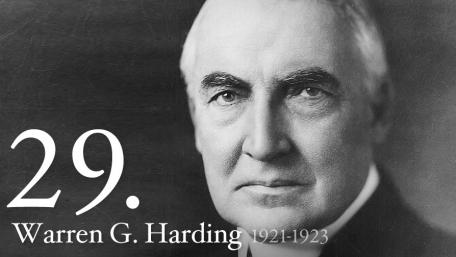
Warren G. Harding, the 29th President of the United States, served from March 4, 1921, until his death on August 2, 1923. His presidency, which began in the aftermath of World War I, was marked by efforts to return to normalcy, significant domestic and international challenges, and controversies that would overshadow his administration. This article provides a detailed timeline of Harding’s presidency, highlighting key dates and events that defined his time in office.
Early Presidency and Domestic Policies: 1921-1922
- March 4, 1921: Warren G. Harding is inaugurated as the 29th President of the United States. Harding’s inaugural address emphasizes a return to “normalcy,” focusing on reducing the influence of government in everyday life and restoring pre-war economic stability.
- March 5, 1921: Harding appoints his Cabinet, including Charles Evans Hughes as Secretary of State, Andrew Mellon as Secretary of the Treasury, and Herbert Hoover as Secretary of Commerce. These appointments reflect Harding’s emphasis on experienced and business-oriented leadership.
- April 22, 1921: Harding signs the Budget and Accounting Act into law. This Act establishes the Bureau of the Budget and aims to improve government efficiency and financial oversight by requiring a systematic budget process.
- June 12, 1921: Harding addresses Congress regarding the need for tariff reform. He supports the passage of the Fordney-McCumber Tariff Act, which raises tariffs on imported goods to protect American industries and promote economic recovery.
- August 2, 1921: Harding signs the Revenue Act of 1921, which reduces income tax rates and aims to stimulate economic growth. The Act reflects Harding’s commitment to reducing the tax burden on individuals and businesses.
Foreign Policy and International Relations: 1921-1922
- November 12, 1921: The Washington Naval Conference begins. Harding convenes this international conference to address naval armament and promote disarmament. The conference leads to several treaties aimed at reducing naval armaments and easing tensions among major powers.
- February 6, 1922: The signing of the Five-Power Naval Treaty occurs. This treaty, concluded at the Washington Naval Conference, limits naval construction and establishes ratios for warship tonnage among the United States, Great Britain, Japan, France, and Italy.
- August 1922: Harding’s administration faces criticism for its handling of international affairs, particularly related to the oil industry. The Teapot Dome scandal begins to emerge, involving allegations of corruption and bribery related to the leasing of federal oil reserves.
Domestic Challenges and Scandals: 1922-1923
- March 1922: The Harding administration begins facing scrutiny over allegations of corruption within the Department of the Interior. The Teapot Dome scandal, involving Secretary of the Interior Albert Fall, begins to attract public and media attention.
- April 1922: The Justice Department launches investigations into the Teapot Dome scandal. Reports emerge of bribery and illegal leasing of federal oil reserves, leading to increasing concerns about corruption within the Harding administration.
- November 1922: Harding’s administration continues to grapple with economic challenges and political controversies. Despite efforts to address domestic issues and improve governance, public confidence in the administration is eroded by ongoing scandals.
- January 1923: The first major trial related to the Teapot Dome scandal begins. Albert Fall, the Secretary of the Interior, is charged with bribery and corruption, leading to a highly publicized legal case that further tarnishes Harding’s reputation.
Illness and Death: 1923
- June 1923: Harding embarks on a cross-country tour, known as the “Voyage of Understanding,” aimed at connecting with the American people and addressing political and economic issues. During the tour, Harding’s health begins to deteriorate, raising concerns about his ability to lead effectively.
- July 1923: Harding’s health worsens, and he experiences a series of severe health issues. Despite his declining condition, he continues to make public appearances and address national issues, although his ability to govern is increasingly compromised.
- August 2, 1923: President Warren G. Harding dies of a heart attack in San Francisco, California. His sudden death marks the end of his presidency and leads to the immediate assumption of office by Vice President Calvin Coolidge.
Legacy and Impact
Warren Harding’s presidency is marked by several key achievements and challenges:
- Return to Normalcy: Harding’s campaign promise to return to normalcy reflects a desire to move away from the progressive reforms and wartime policies of his predecessors. His administration focuses on economic recovery and reducing government intervention.
- Economic Policies: Harding supports several economic measures, including tax cuts and tariff reforms, aimed at stimulating economic growth and protecting American industries. The Revenue Act of 1921 and the Fordney-McCumber Tariff Act are notable examples of his economic policies.
- Foreign Policy: Harding’s efforts to promote disarmament and address naval armament through the Washington Naval Conference represent a significant aspect of his foreign policy. The Five-Power Naval Treaty reflects a commitment to reducing global tensions and promoting international cooperation.
- Scandals and Controversies: The Teapot Dome scandal, involving allegations of corruption and bribery within the Harding administration, casts a long shadow over his presidency. The scandal leads to significant public and legal scrutiny, impacting Harding’s legacy.
- Health and Leadership: Harding’s declining health and untimely death impact his presidency and contribute to a perception of ineffective leadership. His sudden death leads to the assumption of office by Vice President Calvin Coolidge, who continues the administration’s policies.
Conclusion
Warren Harding’s presidency was a period of significant transition and challenge for the United States. While his administration focused on economic recovery and international diplomacy, it was ultimately overshadowed by scandals and controversies that marred his legacy. Harding’s efforts to return to normalcy and address domestic and international issues reflect a complex and multifaceted presidency. His untimely death and the subsequent revelations of corruption highlight the challenges of leadership during a turbulent era in American history.